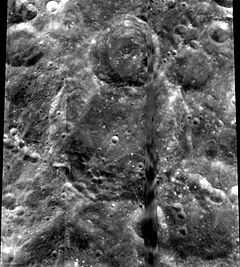
Summary
Larmor is a crater on the Moon's far side. It is located to the east-southeast of Shayn and due north of Dante. It is named in honor of the physicist Joseph Larmor.
 LRO image, with Larmor Z at top | |
| Coordinates | 32°06′N 179°42′E / 32.1°N 179.7°E |
|---|---|
| Diameter | 97 km (60 mi) |
| Depth | Unknown |
| Colongitude | 180° at sunrise |
| Eponym | Joseph Larmor |



The rim of Larmor is broken across by the satellite crater Larmor Z. The remaining rim is slightly worn, particularly to the southwest, and the inner wall is somewhat wider at the southern end. The wider southern inner wall displays terrace structures. Near the midpoint of the otherwise relatively level interior floor are some low hill features.
The satellite crater Larmor Q, located about one and a half crater diameters to the southwest of Larmor, has a ray system. These rays lie primarily within cones to the north and southeast, which leave a 120° arc to the west which is free of ray material. The crater is fresh, with an impact melt splash pool at the bottom and lobes of melt that have flowed down the outside of the rim.[1]
The crater was named after Joseph Larmor by the IAU in 1970.[2]
Satellite craters edit
By convention these features are identified on lunar maps by placing the letter on the side of the crater midpoint that is closest to Larmor.
| Larmor | Latitude | Longitude | Diameter |
|---|---|---|---|
| K | 30.3° N | 179.0° W | 24 km (15 mi) |
| Q | 28.6° N | 176.2° E | 22 km (14 mi) |
| W | 33.3° N | 177.6° E | 27 km (17 mi) |
| Z | 33.7° N | 179.8° W | 49 km (30 mi) |
-
Oblique view of part of Larmor Q crater
References edit
- ^ A Splendid View of Larmor Q, Lunar Reconnaissance Orbiter team, Posted by J. Stopar on May 13, 2014 05:00 UTC.
- ^ Larmor, Gazetteer of Planetary Nomenclature, International Astronomical Union (IAU) Working Group for Planetary System Nomenclature (WGPSN)
- Andersson, L. E.; Whitaker, E. A. (1982). NASA Catalogue of Lunar Nomenclature. NASA RP-1097.
- Blue, Jennifer (July 25, 2007). "Gazetteer of Planetary Nomenclature". USGS. Retrieved 2007-08-05.
- Bussey, B.; Spudis, P. (2004). The Clementine Atlas of the Moon. New York: Cambridge University Press. ISBN 978-0-521-81528-4.
- Cocks, Elijah E.; Cocks, Josiah C. (1995). Who's Who on the Moon: A Biographical Dictionary of Lunar Nomenclature. Tudor Publishers. ISBN 978-0-936389-27-1.
- McDowell, Jonathan (July 15, 2007). "Lunar Nomenclature". Jonathan's Space Report. Retrieved 2007-10-24.
- Menzel, D. H.; Minnaert, M.; Levin, B.; Dollfus, A.; Bell, B. (1971). "Report on Lunar Nomenclature by the Working Group of Commission 17 of the IAU". Space Science Reviews. 12 (2): 136–186. Bibcode:1971SSRv...12..136M. doi:10.1007/BF00171763. S2CID 122125855.
- Moore, Patrick (2001). On the Moon. Sterling Publishing Co. ISBN 978-0-304-35469-6.
- Price, Fred W. (1988). The Moon Observer's Handbook. Cambridge University Press. ISBN 978-0-521-33500-3.
- Rükl, Antonín (1990). Atlas of the Moon. Kalmbach Books. ISBN 978-0-913135-17-4.
- Webb, Rev. T. W. (1962). Celestial Objects for Common Telescopes (6th revised ed.). Dover. ISBN 978-0-486-20917-3.
- Whitaker, Ewen A. (1999). Mapping and Naming the Moon. Cambridge University Press. ISBN 978-0-521-62248-6.
- Wlasuk, Peter T. (2000). Observing the Moon. Springer. ISBN 978-1-85233-193-1.


